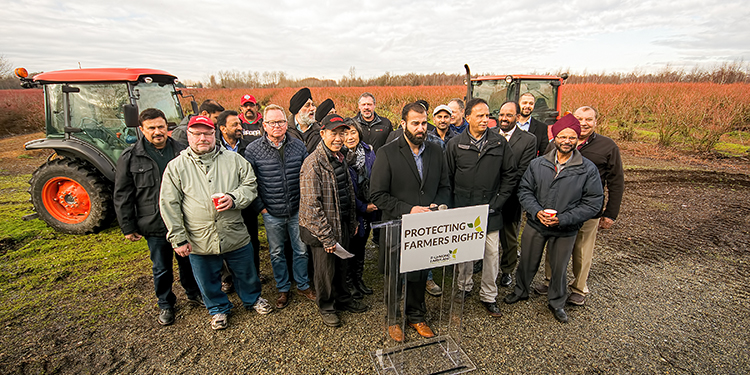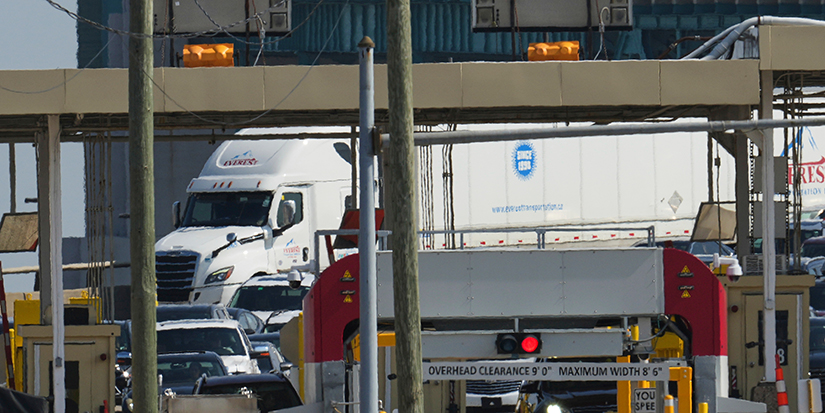Latest News
Farmers say restrictions have gone far enough
Published 1:57 PST, Tue February 20, 2018
Last Updated: 2:12 PDT, Wed May 12, 2021
More than a dozen local farmers and
landowners gathered at a No. 6 Road property on Friday morning to dispel some
myths about the ongoing farmland housing issue while expressing concerns that
special-interest groups may be pressuring politicians to enact more severe
restrictions than are unwarranted.
“There are two sides to this issue, but we
are not combatants,” said Humraj Kallu, who was born into the farming industry,
following in the footsteps of his father who started in the 1960s.
Kallu spoke on behalf of the Richmond
Farmland Owners Association: “Both sides appreciate the value of farming in the
Lower Mainland and recognize its benefits to Richmond’s food security and its
local economy.”
Among the myths the group is trying to dispel
is that larger farm homes decrease the amount of available land for farming.
“This is quite simply not true,” he said.
The current city policy addresses this issue,
he noted, and was adjusted by city hall following consultation with the farming
community last May in response to a spate of mega-mansions that were
constructed on farmland, capturing the attention of locals and garnering media
headlines.
“The current policy restricts the size of the
farm home plate, regardless of the size of the home,” he explained, referring
to the limited area on which a farm owner is permitted to build a house, along
with space for driveways, tennis courts and swimming pools. These together must
fit within the farm’s home plate dimensions.
The city’s new restrictions follow the
provincial guidelines and in certain instances are more restrictive than the
province’s, Kallu said.
Changing the size of the house—which on ALR
land is restricted to two-and-a-half storeys—will not increase the availability
of farmland, he said.
Another myth: Larger homes will lead to
farmland degradation.
“Farmers are required to implement stringent
ecological safeguards and at the end of the day, it would be disastrous for
farmers to damage the very land that they rely on to make a living,” he said.
“Ultimately, the people arguing on the other
side of this issue are good citizens and are standing up for what they believe
to be necessary to ensure the future of agriculture in Richmond.”
While this is a noble endeavour, Kallu said
they fail to understand the realities of the farming industry.
“We understand why people have a tendency to
leap to conclusions regarding farm homes. They see large homes sitting on
agricultural land and assume that it is either damaging the soil or is simply
too lavish.”
Richmond Coun. Harold Steves said the current
six-month review was planned when the original changes were implemented last May.
He said he hasn’t been lobbied by anybody
other than the Richmond Farmland Owners Association.
Steves said he remains concerned about the
size of the houses being placed on farmland and suggested that farmers should
be required to apply to both the city and Agricultural Land Commission should
they wish to build a home beyond the provincial guideline maximum of about
5,500 square feet.
To build a larger home, the farmers would
have to prove there’s enough work on the farm to warrant the increase.
From his perspective, Steves believes farmers
just want to build larger homes because of the increase in value to their
property.
“They’re just in it for the money, and you
can quote me on that,” Steves told The Richmond Sentinel.
Coun. Carol Day isn’t satisfied with last
year’s changes either.
She agreed with Steves, and said farmers
wanting a larger home should be required to apply to the City of Richmond and
the Agricultural Land Commission for approval.
Day insisted that larger homes result in less
farmable land. While the province allows a certain square footage for the farm’s
home plate, that doesn’t mean some of that home plate area can’t be used to
grow crops, she explained.
Kallu said images of numerous opulent mega
mansions have fueled the most recent round of public backlash, but he noted
these homes were approved prior to last May’s new policies.
Under the new rules, none of these homes
would have been approved on even the largest tracts of farmland, he noted.
He questioned the wisdom of implementing further
changes before having the opportunity to measure the full impact of May’s
restrictions.
Building large farm homes is pragmatic both
from an economic and practical perspective, he said.
A large home on farmland acts as a purchasing
incentive for new generation farmers, who are often nurses or teachers with
full-time jobs who either farm for extra income, or who lease out the land at
affordable rates.
“The ability to lease farmland for a token
amount is unique to Richmond,” he said. “It allows for a young, vibrant farming
community.”
Large homes also serve a practical purpose
for farmers, providing housing to those who work on the farm on a day-to-day
basis.
The new farm home policies were developed in
a consultative fashion, he said, with city council working alongside pioneering
local farming families, local community groups and the Richmond Farmland Owners
Association.
“These regulations were evidence based,
pragmatic, practical and (ensure) farming in Richmond would continue for
generations to come,” he said. They were a fair compromise, he added.
Since those new regulations came into effect,
11 farm home applications have been submitted to the city, with a reduction in
farm home size of 32 per cent, he said.
“This is clear evidence that the current
bylaws are working,” he said.
Speaking on behalf of the farmland owners,
the association said farmers feel targeted by “individuals who unfortunately do
not understand the realities of farming in our community.”
The result is economic uncertainly in the
local farming community, he said, and places long-term sustainability at risk.
“We are deeply concerned that non-farmers are
exerting political pressure to tell farmers how to best run their households
and their agriculture businesses.”































